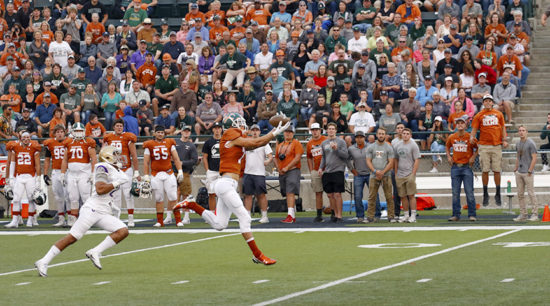‘Clarity of Purpose’
Montana Tech coach’s philosophy of understanding can help teams move forward
As a coach, my mind is constantly on my craft. During the season, I’ll awake in the middle of the night with an idea, making sure to write it down before I go back to sleep. Any time I’ve relayed to my players how I conceived an idea, I get some odd looks. Most players don’t understand that we live our jobs as coaches, on and off of the playing field. Getting them to understand what we do isn’t paramount to our success, but understanding what they go through as student-athletes can help us tremendously.

My first season as offensive coordinator with the Montana Tech football program was 2014. I installed a new offensive system, and we finished the year with a 1-9 record. We couldn’t finish games and the schematic differences weren’t helping, but I knew there had to be another reason for our lack of success.
Our staff believed we weren’t far from a turnaround. We recruited hard, our players were committed during the offseason, and we made strides during spring practice. But it wasn’t until after spring football that I personally took the step I needed to help our players succeed.
In coaching, it’s commonplace to use ideas we garner from others. In the summer of 2015, I listened to Urban Meyer speak at the Mississippi State Coaches Clinic. Meyer shared a lot of insight about coaching, but what stood out to me were his thoughts on “clarity of purpose.” At Ohio State, clarity of purpose is the basic thought of making sure the athletes are clear on what they’re doing. I adopted that initial concept but took it a step further. For me, it was the question of why there wasn’t clarity that made a difference.
Coaches owe it to their players to give them as much clarity as possible on what’s being called. We talk about putting players in position to make plays and be successful. I preached that philosophy for years, but I had never grasped how important it is to make sure our players understand what we’re asking of them. There’s no doubt that a lot of coaches think their players understand, but it’s not the case.
This epiphany changed me as a coach, and I was able to use this approach during the 2015 season. Both our starting and backup quarterbacks were injured by our fourth game, and we had to alter our offensive attack. Four different players who didn’t play quarterback took snaps, and we were coming up with new plays each week. But, more than anything, I put great concentration in running what we could handle mentally. I had to make sure that we weren’t doing too much.
It was a foreign concept for our All-American running back to be calling plays at the line of scrimmage. I had to make sure he could mentally handle the verbal calls and execute the play. We also did that with two of our wide receivers, and I had to make sure I wasn’t overloading them with information. There had to be clarity of purpose. For most of eight games, we used our alternative quarterback attack and won eight in a row.
We finished the 2015 season 10-2, won our conference and advanced to the playoff quarterfinals. The clarity among our players enabled them to simply play ball. It was a constant pursuit for us offensively, and I know it helped our players succeed. We again finished 10-2 in 2016, and last season ended the year 6-4. Clarity of purpose is a constant pursuit for us, regardless of the situation we are in.
 One of the great pursuits in coaching is trying to fix problems and discover the why when things aren’t going according to plan. If a coach can take a step back and confirm that they aren’t the problem, it allows them to move forward and find a remedy for what’s really happening with their teams. With clarity of purpose in mind, here are some points of emphasis to consider when something negative happens in your program.
One of the great pursuits in coaching is trying to fix problems and discover the why when things aren’t going according to plan. If a coach can take a step back and confirm that they aren’t the problem, it allows them to move forward and find a remedy for what’s really happening with their teams. With clarity of purpose in mind, here are some points of emphasis to consider when something negative happens in your program.
1. Look in the mirror; be self-analytical
The structure .of your program, the plays you call, the rules you have — it all begins with the coaches. If you can’t swallow your ego and consider whether you’re initiating a problem, you’re going to fail. Having been a head coach for two of my 15 years as a coach, I know from experience that can be difficult. You’re trying to lead and carry the flag for your program. But not every mistake is someone else’s fault.
2. Scrutinize the process
When there’s a problem, .identify where you went wrong and whether there’s an alternative way to teach players or staff. If it’s a schematic problem, ask yourself if there’s a better approach. Did you really do a thorough job of explaining things in the first place?
We all have busy schedules, but we can’t let that be the reason we don’t adequately teach our players. The best idea in the world doesn’t mean anything if we’re too rushed to communicate it effectively. It’s invaluable to be self-analytical in our communication.
3. Don’t try to do too much with players
Schemes are .constantly evolving. And it can be tempting to see plays run by another team and feel like adding that to your own arsenal.
This is where I’ve occasionally failed as a coach — running a scheme that my players aren’t capable of running, or employing too much scheme on top of what we do. It doesn’t always mean they’re not physically capable, and it also doesn’t mean you haven’t done a good job of explaining it. But knowing what to leave in and what to leave out is important to your success. It’s a balancing act, but we have to pay attention to the learning process of our players and consider what they can retain.
Success often masks the problems that arise. When coaches have success, they believe that the same steps will produce the same results. Don’t let yourself fall victim to your own success.
Another trap is thinking we’re the sole reason for the program’s success. It’s the athletes who make the plays, and we must be willing to tweak things accordingly. It all starts with a coach who can identify the problem and look inward to understand how they can make their players better.
It’s easy for coaches to get overly locked into their plan, especially when it comes to schemes. We often have a picture in our heads of what we want to see executed. I think that’s one reason we fail to look at ourselves as being the problem when something isn’t properly executed — “I came up with it, I can’t be wrong.”
If we can focus on clarity of purpose, and then analyze our coaching when mistakes are made, we can correct those mistakes more quickly. It doesn’t mean players aren’t wrong; they’re going to make a lot of mistakes. But there’s no waiver wire in high school or college, so we have to play with what we have. That means we must find the quickest and most efficient way to remedy the problem. If we can identify why mistakes are made, and make sure we’re doing what’s necessary to provide clarity, we can improve both our players and programs.
Pete Sterbick is the offensive coordinator and quarterbacks/running backs coach with the Montana Tech football program.





